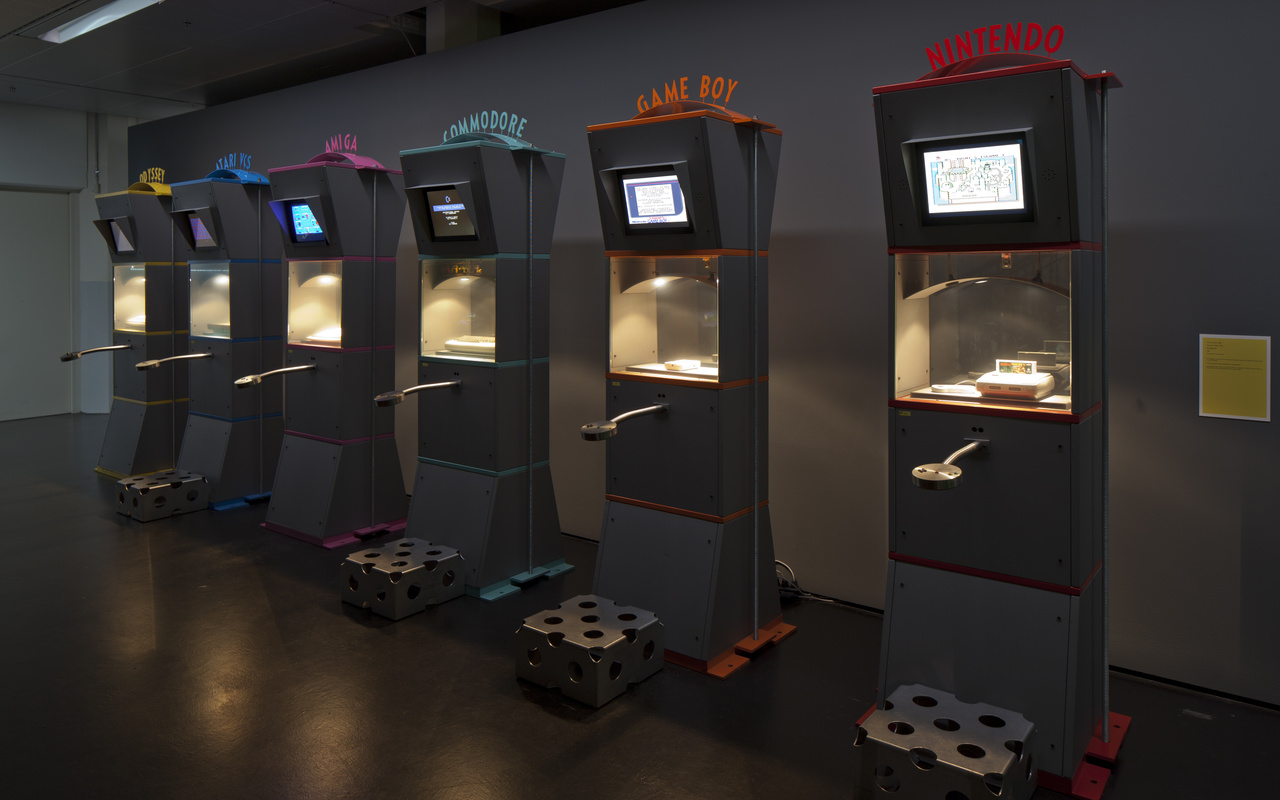Ahnengalerie
Frank de Oudsten und Friedemann Schindler – 1996
The artwork »Ahnengalerie« by Frank den Oudsten and Friedemann Schindler was build for the first computergame exhibition of the ZKM »Welt der Spiele« in 1997. It presents six historical game consoles and home computers in a unique housing.
Philips Odyssey 2001/Magnavox Odyssey 4000 (1977)
The Artwork starts with the »Philips Odyssey 2001« from 1977. The origins of this console can be found in a project by Ralph Baer, who is seen historically as the father of videogame consoles. In 1972, the american electronics company »Magnavox« released the Baers Project as the first commercial videogame console »Odyssey«. The different games on this console are variations of one of the oldest video games, »Pong«. In 1975 the dutch electronics company »Philips« acquired »Magnavox« and released and developed updates of the »Odyssey« till 1983. The »Odyssey 2001« is the second version of the »Odyssey«.
The featured and playable game of the artwork is the alltime classic and evergreen »Pong«. This game can be understand as a abstract interpretation of Tennis.
Atari VCS (1977)
In 1977, »Atari« released it´s first gaming console. The »Atari Video Console System« (VCS, later Atari 2600). In the end oft he 1970s, the company was famouse for it´s arcade cabinets like asteroids [LINK!!!]. »Atari« brought their videogames into homes with the »VCS« and it was a stunning success. The console pushed videogames to being part of the pop culture. »Atari« became to the most interesting company of the Silicon Valley. After the hype of the »VCS« the big videogame crash between 1983-1985 hits the American videogame industry. This also meant later the end of the origin »Atari Inc.«.
The visitors can play the maze-game »Ms. Pac-Man« from 1982. The eponymous heroine of the game is the first female protagonist in a videogame.
Commodore C64 (1982)
The »C64« is a home computer by »Commodore«, which was produced between 1982 till 1994. The name based on the 64 Kilobyte of internal memory. The processor works with 1MHz. As a home computer, the »C64« was not only used for gaming. Also programming or writing documents were some of the key features. The success of the »C64« was not only based on the affordable and powerful hardware for this time. Also the sharing of illegal software copies made it popular, especially on schoolyards. Cracker groups competed in being the first one cracking the copy protections. This milieu is also the origin of the »Demoscene«, which used the audiovisual hardware power for digital artworks.
Four games are playable for the visitors: »Fiendish Freddy’s Big Top O’Fun«, »Flimbo’s Quest«, »Klax« und »International Soccer«
Commodore Amiga A600 (1992)
»Commodore« released in 1992 the »Amiga 600«, which was an marginal updated version of the »Amiga 500 Plus«. Both home computers weren´t really successful. The videogame and software market in the 1990s was dominated by IBM compatible Personal Computers and consoles by Nintendo and SEGA.
The visitors can race in the arcade racing game »Lotus Esprit Turbo Challenge«. The challenge is not only to overtake other racers. It is also necessary to reach the checkpoints in a limited time otherwise the game ends.
Nintendo Gameboy (1989)
With the »Gameboy« gaming was released from the living rooms and stationary fixed televisions. Gaming becomes a portable activity that happens now outside or during commuting. The hardware fby »Nintendo« was not very powerful for a handheld console when it was released. But the monochrome display with 4 shades of grey and the 4MHz processing unit granted a long battery life. The »Gameboy« was the most successful console with almost 120 million copies sold until the follow-up handheld-series »Nintendo DS« acclaimed this place.
The »Ahnengalerie« uses the »Super Gameboy«, a cartridge for the »Super Nintendo Entertainment System«, which made it possible to play the games on a television with colour interpolation. The visitors can play the all-time classic »Tetris«. The goal of this puzzle game is to sort and rotate falling, different shaped blocks into lines. If a line is complete, it will be destroyed and the players will be rewarded with points.
Super Nintendo Entertainment System (1990)
The last stop of the »Ahnengalerie« is the 1990 published »Super Nintendo Entertainment System« (SNES). In company with the »SEGA Megadrive« it defined the age of the fourth generation of video game consoles. This was also the last generation, which was dominated by 2-dimensional graphics. The gamepad of the »SNES« is a milestone from a design perspective. This classic button layout with a directional pad, four action buttons on the front and two shoulder buttons can still be found on most of the gamepads from today. In competing of the upcoming CD driven consoles and computers, »Nintendo« and »Sony« developed a never released CD-Drive expansion for the »SNES«. After the abort of the project »Sony« used their obtained expertise to develop their own videogames console, the »PlayStation«.
The visitors can play »Super Mario World« on the »SNES«. This platform game is still be seen as one of the best of its kind. It was also the first title of the Super Mario brand with the ever-hungry dinosaur »Yoshi«. The players have to move to the right side of the levels and overcome enemies and jump and run from platform to platform without falling into pits.
Text by Jerome Nguyen
